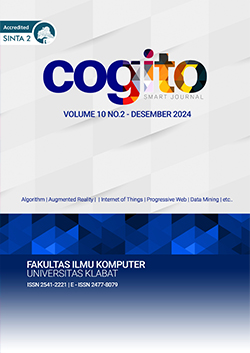Design and Development of a Web-Based School Information System
DOI:
https://doi.org/10.31154/cogito.v10i2.858.593-606Keywords:
School Information System, Web, SMK Negeri 1 SorongAbstract
The rapid development of information technology has had a significant impact on various fields, including education. This study aims to design and develop a web-based school information system for SMK Negeri 1 Sorong to enhance efficiency in data management and the dissemination of academic and non-academic information. The methodology used follows the Waterfall system development model, which includes requirements analysis, system design, implementation, testing, and maintenance. The research results indicate that the system, developed using PHP as the programming language and MySQL as the database, operates stably and provides users with flexible access. This system facilitates the integration of student data, teacher data, class schedules, and other related information. Testing confirmed that all system functions operate according to the designed specifications. With the implementation of this system, SMK Negeri 1 Sorong can improve the quality of educational services, simplify information access, and support digital transformation in the education sector. Furthermore, the results of this study have the potential to be applied and adapted in other educational contexts, particularly in the development of web-based school information systems that can be customized according to the needs of other educational institutions.References
A. Junaedy, A. Huraerah, A. W. Abdullah, and A. Rivai, “Pengaruh Teknologi Informasi Dan Komunikasi Terhadap Pendidikan Indonesia,” J. Penelit. dan Kaji. Sos. Keagamaan, vol. 18, pp. 133–146, 2021, [Online]. Available: https://dx.doi.org/10.31958/jaf.v11i2.10548
A. Fitri, Tahrun, and J. A. Mentari, “Implementasi Teknologi dalam Pendidikan Era Globalisasi,” Pros. Semin. Nas. Pendidik., vol. 1, no. November, pp. 55–59, 2022.
R. Lontaan, S. I. Adam, O. Lengkong, V. S. Weol, and G. V. A. Poluan, “Development of Web-Based Uteach Tutoring Application,” CogITo Smart J., vol. 10, no. 1, pp. 285–297, 2024, doi: 10.31154/cogito.v10i1.669.706-718.
K. C. Laudon and J. P. Loudon, Management Information Systems: Managing the Digital Firm, 17th ed. Pearson Education, 2021.
R. Hammad et al., “Pembuatan Website Sekolah Sebagai Media Informasi dan Promosi,” Bakti Sekawan J. Pengabdi. Masy., vol. 2, no. 1, pp. 22–26, 2022, doi: 10.35746/bakwan.v2i1.216.
N. Putri et al., “Inovasi Pemanfaatan Teknologi Informasi Dalam Meningkatkan Efisiensi Manajemen Pendidikan Di Mis 05 Darussalam,” Ar-Risalah Media Keislam. Pendidik. dan Huk. Islam, vol. 22, no. 1, p. 033, 2024, doi: 10.69552/ar-risalah.v22i1.2372.
I. Febrianti, W. Aidin, M. Andila, M. Faqih, A. Harahap, and T. Darmansah, “Peran Teknologi Informasi Dalam Meningkatkan Korespondensi Sekolah di MAS PAB 1 Sampali,” vol. 2, no. 2, pp. 332–342, 2024, [Online]. Available: https://doi.org/10.59059/mandub.v2i2.1232
F. Yuda, K. Sabri, Dona, R. Puspita, and M. Rasyid, “Sistem Informasi Akademik Sekolah Menengah Kejuruan ( SMK ) Terpadu Ujung Batu Berbasis Web,” Riau J. Comput. Sci., vol. 10, no. 2, pp. 82–87, 2024.
I. Zulfa and R. Wanda, “KLIK: Kajian Ilmiah Informatika dan Komputer Rancangan Sistem Informasi Akademik Berbasis Website Menggunakan PHP dan MySQL,” Media Online, vol. 3, no. 4, pp. 393–399, 2023, [Online]. Available: https://djournals.com/klik
E. Turban, C. Pollard, and G. Wood, Information Technology for Management: On-Demand Strategies for Performance, Growth and Sustainability, 12th ed. Wiley, 2021.
S. Salsabila, “Aplikasi Berbasis Web: Pengertian, Jenis, Contoh dan Kelebihannya,” exabyte, 2024. https://www.exabytes.co.id/blog/aplikasi-berbasis-web/ (accessed Dec. 22, 2024).
A. Anendya, “Aplikasi Berbasis Web: Pengertian, Jenis, Contoh, & Keunggulan,” DewaWeb, 2023. https://www.dewaweb.com/blog/aplikasi-berbasis-web/ (accessed Dec. 22, 2024).
R. Junius Lontaan and S. Wellem Taju, “Pengenalan Artificial Intelligence (AI) Kepada Siswa/I Smk Negeri 1 Sorong (Introduction to Artificial Intelligence (AI) for Students of SMK Negeri 1 Sorong),” Julyxxxx, vol. x, No.x, no. x, pp. 1–5, 2022.
A. A. Wisesa and N. Hariyati, “Pengembangan Sistem Informasi Sekolah Berbasis Website Di Sd Negeri Asemrowo 2 Surabaya,” J. Inspirasi Manaj. Pendidik., vol. 10, no. 03, pp. 674–686, 2022, [Online]. Available: http://sdnasemrowoiisurabaya.mysch.id
B. Sirodjuddin, Ardan; Murniati, “Perancangan Sistem Informasi Manajemen Sekolah Berbasis Website Di Smkn 10 Semarang,” J. Manaj. Pendidik., vol. 12, pp. 2654–3508, 2023.
A. T. Mulyadi, R. Meimaharani, and T. Khotimah, “Peningkatan Efisiensi Pengelolaan SPP Siswa Berbasis Web dengan Pendekatan Metode Agile Development,” vol. 6, no. 2, pp. 1008–1018, 2024, doi: 10.47065/josh.v6i2.6458.
A. A. Wahid, “Analisis Metode Waterfall Untuk Pengembangan Sistem Informasi,” J. Ilmu-Ilmu Inform. dan Manaj. STMIK, 2021.
S. I. Adam, R. J. Lontaan, V. V. Supit, and S. Cerolin, “Digital Information and Navigation Kiosk Application Based on Progressive Web Apps and Leaflet Technology,” CogITo Smart J., vol. 10, no. 2, pp. 393–402, 2024, [Online]. Available: https://doi.org/10.31154/cogito.v10i2.745.393-402
K. N. Cahyo, “PHP & MySQL Fundamentals,” brainmatics, 2023. https://brainmatics.id/php-mysql-fundamentals/ (accessed Dec. 22, 2024).
S. Sukisno, “Perancangan Sistem Informasi Puskesmas Menggunakan PHP dan Database MySQL,” UNISTEK, vol. 5, no. 1, pp. 23–27, Jan. 2018, doi: 10.33592/unistek.v5i1.281.
Downloads
Published
How to Cite
Issue
Section
License
Copyright (c) 2025 CogITo Smart Journal

This work is licensed under a Creative Commons Attribution 4.0 International License.
Authors who publish with this journal agree to the following terms:- Authors retain copyright and grant the journal right of first publication with the work simultaneously licensed under a Creative Commons Attribution License that allows others to share the work with an acknowledgment of the work's authorship and initial publication in this journal.
- Authors are able to enter into separate, additional contractual arrangements for the non-exclusive distribution of the journal's published version of the work (e.g., post it to an institutional repository or publish it in a book), with an acknowledgment of its initial publication in this journal.
- Authors are permitted and encouraged to post their work online (e.g., in institutional repositories or on their website) prior to and during the submission process, as it can lead to productive exchanges, as well as earlier and greater citation of published work (See The Effect of Open Access).





























